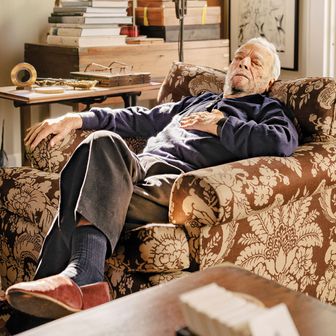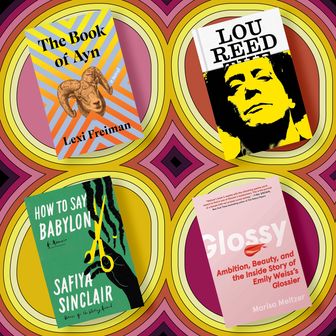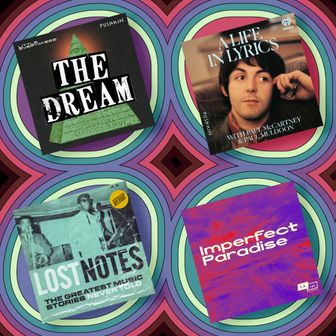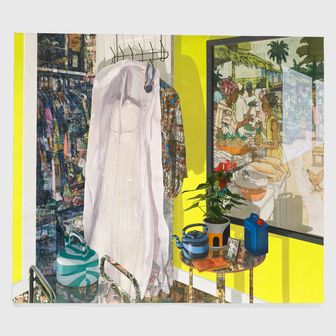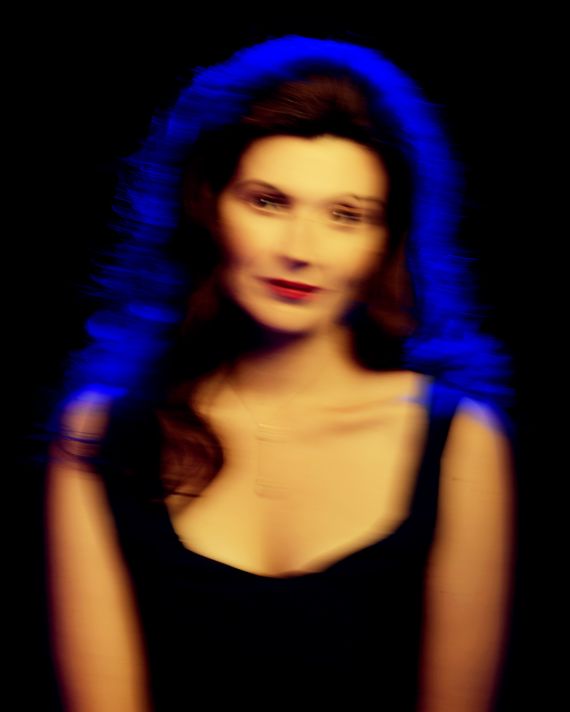
Four years ago, the novelist Mona Awad went to a high-end hotel spa for a facial that seemed to go on for hours. Lying flat on her back in a robe as an aesthetician massaged her face and tried to sell her an epidermal-growth serum, she suddenly felt trapped, as if she were being held there by some sinister conspiracy. Once it had ended, she couldn’t find the exit and wandered through the hotel’s maze of hallways. “I just wanted to get out,” she said. “When I did finally leave, the sun was setting and the sky was very red. And I realized I had left my bracelet and would have to go back.” The idea scared her, but she went inside again. And she thought, Maybe I can use this fear in a book.
The rituals of skin care, performed privately in front of a mirror or received passively at the oiled hands of a professional, become rituals of horror in Awad’s fourth novel, Rouge. At night, her main character, Mirabelle Nour, who also goes by Belle, rubs on chemical exfoliants, such as a “cult French elixir that’s still illegal in some countries”; in the morning, she applies soothing layers: Iso-Placenta Shield, White Pearl Pigment Perfector, Brightening Caviar for Radiance, and a formula that makes her eyes well up. Just as her recently deceased mother once did, Belle approaches these treatments with grim determination. Then she discovers a spa in Southern California that promises beauty beyond what she’s ever imagined — and that might have something to do with her mother’s mysterious death.
Awad writes novels with the cruel logic of fairy tales; as she put it, “All of them have a ‘Careful what you wish for’ quality.” In her debut, 13 Ways of Looking at a Fat Girl; her breakout campus novel, Bunny; and All’s Well, set in the world of college theater, her characters are constantly seeking justice and finding that the scales may not fall in their favor. The results are tragic and funny at once, like the Brothers Grimm stories she grew up reading and now teaches in the English department at Syracuse University. In Rouge — which was inspired by “Snow White” — mirrors come to life, roses bloom “redly,” and jellyfish pulse in a massive fish tank. The mood is baroque and unsettling, and the sentences pulse, too, in fragments tied together with repeated words.
Awad herself wouldn’t look out of place in the world of Rouge. When we met in Soho this summer, she showed up with her long, dark hair resting over one eye. Her voice is musical and gracious, a little like a French Canadian Disney princess. We walked into the Sephora on Broadway, where Awad led me to all her favorite “potions,” as she called them, starting with SK-II’s yeast essence (“A miracle water, right?”).
“I’ve gone through the whole byzantine ritual,” she said: scorched herself with acids, soothed herself with mists, locked it all in with moisturizing agents. “Now I’m on the other side, where I’m still vulnerable. But I know from experience there are things my face can’t take.” In Rouge, Belle is addicted to watching skin-care videos; Awad said the book was inspired in part by YouTubers who throw their heads back in ecstasy over certain products. The burning, the shedding, the uncanny radiance followed by pimples and other signs of biological recoil — it’s all part of the fantasy of transformation. We walked by a display for the Dr. Dennis Gross mask, a metallic device with a gaping mouth that you place over your face; it works by shining 100 red LED lights onto your skin. Awad shuddered. “It terrifies me to my core,” she said. “There’s how beauty can slip into horror so fast. I mean, it’s almost painfully obvious.”
Like Belle, Awad was born in Montreal to an Egyptian father and a white French Canadian mother. Her mom, Nina, who died in 2004, was nothing like the mother in the book, who is troubled and distant — though some inherited habit of self-loathing informed Rouge’s mother-daughter dynamic. “There were things about my mother’s face that I envied,” Awad said, “and I think there were things about me that my mother longed toward.” Her parents divorced when she was 7, and she and Nina lived on Nuns’ Island in Montreal. It was the height of Quebec’s politically charged push to make French its official language, but Nina chose to send Mona to an English school, almost as if she expected her to leave the province someday. Raised an Anglophone child in a mostly French-speaking family, Mona felt isolated.
After long shifts working at a diner downtown, Nina would read for hours at night — spy novels by John le Carré or salacious paperbacks like Scruples, by Judith Krantz, and Rage of Angels, by Sidney Sheldon. Mona read those books, too, then moved on to poetry and literature by Albert Camus, Samuel Beckett, and the Canadian poet Gwendolyn MacEwen. She fell into a depression that she didn’t know how to contend with; she dropped out of high school three times and college once. But after she and her mother moved to a suburb of Toronto in the early ’90s, teenage Mona discovered the goth scene. She would dress up in a black cape, with heavy eyeliner and deep-red lipstick, to go to clubs like Sanctuary and Velvet Underground. “It was so important to my survival,” she said. “I loved the interest in beauty. I loved the interest in being over the top. I loved the interest in melancholy.” And she really loved the dry sense of humor about it all.
Awad married an American and moved with him to Salt Lake City, where she joined a belly-dancing troupe (partly to reconnect with her Egyptian ancestry, though the group was run by a white woman who called herself “Yasamina”), found SLC’s tight-knit goth community, and worked at a bookstore. She completed a master’s at the University of Edinburgh, spending “a year looking at fairy tales”; her thesis was on fear. Meanwhile, she was writing. Poetry was her entry point. She had written a surreal restaurant column for a Montreal magazine as a character named Veronica Tartley, but what she really wanted to do was fiction. She enrolled in Brown’s creative-writing program, where she finished a manuscript, an aching novel about a young woman’s body image modeled in part after Allen Ginsberg’s “Howl” — its rawness and its confessional mode. That became her first published book in 2016, 13 Ways of Looking at a Fat Girl.
Three years later, she published Bunny, about a clique of cutesy M.F.A. students, all women, who call one another “Bunny” and conjure up fawning male suitors through an absurd ritual involving exploding rabbits. The book is snappy and cinematic, sugary with a nasty streak, and it was a hit — best selling, well reviewed, and optioned for film by J. J. Abrams’s production company. It’s a fixture on BookTok, where its fans tend to label it part of the “dark academia” genre and the hot-pink cover shows up in videos with titles like “weird books for weird girls” and “POV: You’re mentally unwell.” The novel she wrote next is darker and more difficult to classify: All’s Well follows Miranda, a recently divorced theater professor afflicted with spiderwebs of chronic pain. The book is unapologetically bitter; like her main character, Awad had gone through a divorce and was facing complex repercussions following hip surgery. “I couldn’t believe how much the pain affected my daily life,” she said. The fear, vulnerability, and absurdity of it were shocking, and she found herself dreaming of a miraculous recovery. In All’s Well, her protagonist seems to find that: She gains the power to transfer her pain to others.
Awad’s own pain still hasn’t gone away completely, though it has eased with time. She no longer wonders whether she’ll be able to do something as simple as get in and out of her car. She’s now in La Jolla, California, where she rents an apartment to write novels and is already working on her next book, a prequel to Bunny. (She’s also in the middle of a proposed class-action lawsuit against OpenAI, alleging the company used copies of her and other authors’ books to develop ChatGPT without permission; she declined to discuss it.) Although All’s Well takes some of its structure from Shakespeare — both the play of that name and Macbeth — fairy tales remain her through-line. Bunny was inspired by the Brothers Grimm’s “The Hare’s Bride.” While writing Rouge, she thought about the unnerving relationship between the queen and her mirror in “Snow White”: “That intimacy, that dynamic between the two, the mirror’s knowledge of her. It’s almost like we’re in her mind.” Rouge may revolve around physical beauty, but Awad doesn’t think the desire to work on your face is really about vanity. “It’s a longing to look in the mirror and see someone you recognize,” she said. “When people pursue treatments of any kind that address the surface, I think that’s a kind of existential quest: wanting to see the self that you think is you.”
More From fall preview 2023
- Which Fall 2023 Comedian Memoir Is Right for You?
- Sampha’s Circle of Life
- All Eyes on Lily Gladstone



